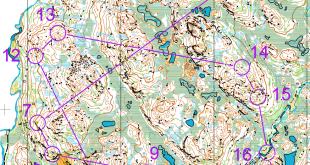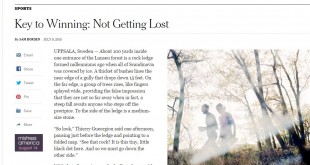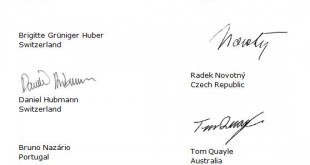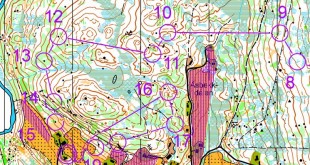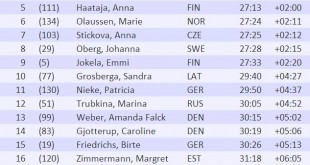 Next week during the World Orienteering Championships (WOC) in Scotland a decision will be taken about the future of the WOC: IOF is calling an Extraordinary General Assembly in order to discuss a proposal for splitting today’s WOC into a forest part and an urban part.
Next week during the World Orienteering Championships (WOC) in Scotland a decision will be taken about the future of the WOC: IOF is calling an Extraordinary General Assembly in order to discuss a proposal for splitting today’s WOC into a forest part and an urban part.
In July 2015 Matthias Niggli, Janne Salmi, Simone Niggli and several other coaches, elite athletes, former elite athletes and other important orienteering personalities have written an open letter to the IOF Council and National Federations where they are opposed to the suggestion of splitting the WOC – and where they name a number of risks by splitting the WOC. Although there are many good arguments in the letter, it is not written in an objective way – highlighting disadvantages with a split WOC without discussing the advantages.
This article tries to discuss the advantages and disadvantages with splitting the WOC in a more objective way. There are, however, many issues here which are difficult to fully answer. Please add a comment if you think the arguments are not well balances, and the article will be changed if possible.
Overall discussion & Main questions
A lot of background material and detailed discussions of different issues is included below for the interested reader. The main questions are discussed here for the ones who don’t have time to read the complete document.
- How much less complexity and how much lower cost is it to organize separate urban/forest WOCs compared to a today’s model? Will it give better locations for each championships? Will this give more applications for WOC and more organizing countries? Higher event quality?
Discussion: Yes it is easier and cheaper to organize a separate urban or forest WOC than a complete WOC. Just reducing the number of days from 8-9 to 5, the number of disciplines with TV production from 5 to 3 (TV is a cost driver; the number of days is a significant part of the budget, even rest days cost money) and so on. But many costs are “base costs” not influenced by the number of competitions/competition days. Complexity is lower for a split WOC, but not very significantly lower.
Conclusion: (1) Just to put up a number: 15-30% less complexity, 25-40% less cost for a single split WOC (either urban or forest) compared to a full WOC. Does anybody have better numbers? (2) Yes, there should be some more applications for a split WOC, it is less complex to organize and there are more places which are suitable – even in a country like Norway there would be more opportunities. But it may turn out – over time – that it is difficult to find organizers for either the urban or forest part due to financing issues. Also, this is a question about the overall competition program (see further below) - How much lower is the cost for teams for participation and preparations for a separat urban/forest WOC compared to today’s model?
Discussion: Reducing the number of days from 8-9 to 5 leads to a significant cut in budget for the teams. Also, preparations for urban races typically require less travel to the host country for preparations.
Conclusion: Again, just to put up a number: 20-25% cost reduction for participation and 15-25% cost reduction for preparation for a split WOC. Does anybody have better numbers? - Will there be more or less of the big profiles on the start in each discipline in a split WOC model than in today’s model? And will some even skip a complete WOC (either forest or urban)?
Discussion: This question is difficult to answer, it can go both ways as more of the potential winners in each discipline will probably start in a split WOC, but the risk of top profiles not being present at WOC at all (for one of the split WOCs) is definitely an issue which is more problematic than today’s situation. Thus there is a real risk of losing some of the top profiles at WOC in a split WOC model.
Conclusion: Split WOC gives bigger downside than today’s model. - How will a split WOC model work towards media? Is it an advantage because WOC can potentially be organized outside the “low key” European summer months, or is it a problem because WOC is different from year to year and it is difficult to understand for media? And is a shorter WOC a problem for media?
Discussion: This is again a difficult question to answer. WOC in the summer months is definitely an issue with respect to media interest (pointed out by media representatives in numerous discussions). The potential problem with a different WOC from year to year or profiles not being present is more difficult to assess – but it will surely be a disadvantage. It has been discussed with several media representatives – the issue with missing profile being pointed to as the main issue.
Conclusion: Split WOC gives potential issues, these are probably more problematic than the advantage of potentially avoiding the summer months. - Will a split WOC lead to either urban or forest WOC getting a “B”-status over time? And even dying?
Discussion: This question has been raised in many discussions. Some I have discussed with fear that the urban disciplines will win because all non-Scandinavian nations will focus on sprint and the urban part of the sport will spread. Others fear that the forest disciplines will win and sprint will die – because the nations with most money focus most on the forest disciplines. These arguments show that both parts have their strengths – and that this problem may be an advantage in that each part may develop better in a separate championship.
Conclusion: No clear conclusion. - Hove does a split WOC work for the “smaller” orienteering nations?
Discussion: The removal of the qualification has been a significant problem for the “smaller” nations who have only 1 (or maybe 2) athletes in middle/long. Many athletes have lost the motivation to focus on the forest disciplines as the chances to run in the forest are small. In a split WOC model there would need to be some sort of qualification reintroduced (there is no other realistic possibility – if not you would not get enough nations participating with most runners only running the relay), which would be good for the “smaller” nations. Note however that you could also include a qualification again in today’s WOC program (e.g. a “low key” type before the actual championships). Lower cost for participating and easier preparation would also be an potential advantage. - How does a split WOC fit into the overall Competition program? Will there also be a split EOC? What about the World Cup?
Discussion: This is probably the most important question in all of the discussion. Depending on how you form the rest of the competition program, the cost savings above may disappear – and overall cost for federations may even be higher than today with a split WOC model. Also, the number of high-quality organizers required may increase rather than decrease, and media questions may also be turned around. For example, if you also split the EOC and organize urban and forest EOC in opposite cycle with WOC, you get one urban championship (WOC or EOC) and one forest championship (EOC or WOC) each year. For this you need high quality organizers – and the team need to pay both travel cost and preparations. Instead of 3 championships every 2 years (2 WOC + 1 EOC) as today, you would have 4 championships every 2 years (2 WOCs and 2 EOCs). Nevertheless, a split EOC is what may very well become the solution. A complete EOC every second year is probably easier to accommodate – or should one skip the EOC completely and focus on the World Cup?
Conclusion: The overall competition program needs to be an integral part of the discussion of a split WOC. - Would it be better to have WOC every second year instead of splitting WOC into two (in order to get enough organizers and ensure quality)?
Discussion: This would probably be a solution to the organizer problem (at least partly), you would only need half the number of organizers. However, each time this is introduced in discussions, the media aspect comes up. It is said that one needs a WOC every year to attract the media. The answer to this is probably that yes, if we don’t have a strong World Cup or European Championship, we need WOC every year. But this is again a question of overall competition program. E.g. Cross Country Skiing works very well with World Champs only every second year, but they have a strong World Cup, and the Olympics.
Conclusion: The overall competition program needs to be an integral part of the discussion of a split WOC. WOC every second year may work, but it would not work well with today’s competition program.
Overall conclusion
The overall conclusion depends on how you weight the various issues. It is, however, quite clear that the overall competition program is an important part of this decision. There are significant potential advantages with a split WOC model, but they may be “eaten up” by a non-optimal overall competition program.
Also, the fundamental problem with WOC today is that the overall organizing costs (including IOF sanction fee, cost for TV production and all other costs) are so high that it is very difficuelt to earn money on organizing WOC (WMOC is part of a “sweetening package” the next years). Are there other more fundamental issues which are more important to sort out than to decide if the WOC is split or not? There is a clear expectation of (live) TV from all WOC disciplines – but with limited sponsors the cost for it is so high that it is not easily sustainable. Does a split WOC solve any of the real issues at hand? A split WOC may solve it better than today’s model, but is the step too small compared to the step necessary to be sustainable?
What do you think? Split WOC or Not? And why?
Pros and Cons Table & Discussion
In the following table some advantages and disadvantages with a split WOC model are set up in a Pros/Cons table. This is not a full discussion of all points, but some of the points from the questions above are further elaborate. Some of these points are also discussed further below.
| Pros/Cons: Split WOC model | Pros/Cons: Todays WOC model |
| Some of the biggest profiles in orienteering may skip the complete WOC (forest or urban) due to specialization.Probability: High (but only pure experts, most would try to run the other WOC, e.g. Gueorgiou would probably run urban?)
Consequence: Profiles not present, lowers interest of media. Consequence is more problematic than athletes skipping disciplines in today’s WOC model. |
All the big profiles in orienteering are present at every WOC. |
| In each discipline, the best athletes in this discipline can be on the start. | Some of the best athletes in a discipline skip the discipline due to too tough program. Probability: High (happens today in all disciplines)Consequence: Profiles not present, lowers interest of media, value of gold |
| Potentially easier to organize a sprint WOC in many locations. Potentially easier to find future WOC organizers because more areas (e.g. big cities or areas without proper urban terrain) are possible venues for a World Orienteering Championships, the event is shorter and thus requires less man hours to organize.
See separate discussion below. |
Difficult to organize a complete WOC in many locations which would be very suitable for either forest or urban.Difficult to find WOC organizers for full WOC weeks – limited number of applications today.
Probability: Medium to High (no applications for WOC 2019). However, there is no guarantee that the situation would be better for a split WOC. Consequence: IOF can not demand base service quality with this level of interest, this potentially reduces event quality for WOC. See separate discussion below. |
| Lower cost for organizers for split WOC as 5 days opposed to 7/8 days.See separate discussion below.
|
Full WOC of 7/8 days is more costly to organize.Probability: Already a problem today.
Consequence: More difficult to get organizers, potentially lower event quality. Discussion: TV is the main cost driver, not the number of competition days. Cutting TV demands would be an alternative way of cutting. See separate discussion below. |
| Lower cost for teams for split WOC, both at the WOC and for preparations. Higher chance for athletes with less budget to be well prepared.
|
Higher cost for teams with a complete WOC, both during WOC and for preparations.Consequence: Potential reduction of participation. Nations with high budget are significantly better prepared. Especially forest WOC is expensive for preparations – and takes a lot of resources from national teams.
|
| Potentially easier to find future WOC organizers as complexity of organization is lower with less diversity in competitions and shorter total duration of WOC. Discussion: Note however that it is still expensive and complex to organize a WOC. Most parts of WOC are common for urban/forest. Complexity is maybe reduced by 20% for a split WOC, not by 50%. Urban WOC is not necessarily easier to organize than forest WOC. | A full WOC is very complex to organize with different competition types over many days. You need both skills for forest WOC and urban WOC. |
| More challenging for an organizer of a pure forest WOC to get financing from the state/region if no races are organized in cities. | Races organized in cities, i.e. potential for funding from state/region |
| Generally more challenging to get the same income through spectator races with a shorter WOC. Specifically more challenging for an organizer of a pure urban WOC to get financing through spectator racesDiscussion: But terrain in nearby forest areas may be used in some cases. There are also other items which can attract orienteering spectators in a bit city. | Forest races, i.e. potential for large spectator races. |
| More suitable terrain for the championships – both forest and urban – as you dont have to do compromises with respect to having both forest and urban terrains available | Compromises with regards to terrain or long travel times as both forest and urban terrain of high quality required for each WOC |
| Potentially easier to find WOC organizers outside Europe because easier to organize and more suitable places available | Difficult to get organizers outside of Europe. |
| Potentially participants from more nations in urban WOC over time(?) | Athletes from all nations in both forest and urban WOC; maybe not exploiting full potential of urban part with respect to participation? |
| Potentially participants from less nations in forest WOC (and possible also urban WOC?) | Athletes from all nations in both forest and urban WOC; no reduction due to nations prioritizing urban only or forest only |
| If the IOF sanction fee is kept constant, the high sanction fee may be a challenge for a smaller split WOC with less income potential. | IOF sanction fee issue as today. |
| Possibility for WOC outside main European summer months for years with urban WOC – possibly also for forest WOC. This is a big advantage with respect to TV/media interest.Discussion: From a media view point, a WOC in autumn (September – October) or spring (May) would probably be better than July – August (this must be confirmed by a media group, but indications have been given when talking to media/TV responsible). For an urban WOC a late autumn or spring WOC might be feasible (spectator races less important, possible with weekend urban spectator races which can be held either sprint or autumn). | WOC usually in summer months due to organizers need for multi-day spectator races and many organizers in a long event. |
| Possibility to introduce first-to-finish discipline on the WOC program | No room for individual first-to-finish disciplines on the WOC program (this must not necessarily be negative). |
| Possibility to re-introduce qualification in forest WOC | No qualification races forest WOC; potential issue for smaller nations |
Discussion: Participation of the best athletes in all disciplines
In todays WOC some of the best athletes do not participate in all WOC disciplines because the program is too tough, even with the qualification races removed. Several athletes skipped either the long distance, the sprint or the sprint relay in order to be fresh for the other races in 2014 – we see a similar situation in Scotland in 2015. This would probably be avoided in a split WOC model. On the other hand a split WOC might lead to WOCs where some of the biggest profiles of orienteering are not participating. E.g. the best pure sprinters would not participate in a forest WOC and the best forest specialists would not participate in an urban WOC. The latter could potentially be reduced by introducing a longer urban discipline in the urban WOC.
Discussion: Easier to find future WOC organizers
A split WOC model makes it potentially easier to find future WOC organizers because more areas are possible venues for a World Orienteering Championships for either urban only or forest only. An example are large cities which are good possible venues for an urban WOC. It is also possible to get more suitable terrain for the championships as you dont have to do compromises with respect to having both forest and urban terrains available close to each other. It is also potentially easier to find future WOC organizers for a split WOC as complexity of organization is lower with less diversity in competitions (urban only or terrain only) and shorter total duration. Note however that it is not easy to organize urban races, but the complexity is still lower than both urban and sprint – and it is also possible to organize a good urban championship with a limited number of external consultants.
The cost of organizing either a forest or urban WOC should be lower than a complete WOC due to the lower amount of competition days. Technical focus can be put on the specifics of each format, i.e. mapping standards and event adviser aspects. The focus on separate formats will also increase technical quality of the respective formats. There does not need to be a compromise in venue quality due to the requirement of both forest and urban venues, and each format can be developed to best fulfil participant and media (TV production) requirements.
Note also that it may be more challenging for an organizer of a pure forest WOC to get financing from the state/region if no races are organized in cities, as this visibility might be important for sponsors. On the other hand it may be challenging to get (as high) income from spectator races for an urban WOC as for a forest WOC.
The important questions here are of course “Which countries are capable of organizing a forest WOC?” and “Which countries are capable of organizing an urban WOC?”. Is there a real difference?
Possibility to re-introduce qualification in forest WOC
A split WOC may make room for re-introducing a qualification race in the forest WOC, e.g. for the middle distance. This is of interest because the current model with qualification through quotas instead of qualification races has very negative consequences with respect to athletes from smaller nations focusing less on forest races.
Background
Some background material:
- Original story at the IOF webpage: Orienteering.org: IOF President calls Extraordinary General Assembly during WOC in Scotland in August
- The IOF proposal is based on an original proposal by NORD in 2014 (the Nordic Federations), but with some modifications being done.
- The NORD proposal from 2014 was again based on a proposal for a Split WOC from the Swedish Orienteering Federation in 2011 – in this World of O article from 2011 the pro/cons of a split WOC model is discussed at length with reference to the situation at the table in 2014. At that point in time, nearly 80% of World of O’s readers wanted a split WOC model – but the reason for the high numbers was that the alternative was to remove the qualification races (which there was very strong opposition against) and to introduce the new (untested) discipline Mixed Sprint Relay, possibly replacing the traditional same-gender relay. Finally the Split WOC proposal was not introduced when the decision to change the WOC program was made in 2012 (see WOC history further down).
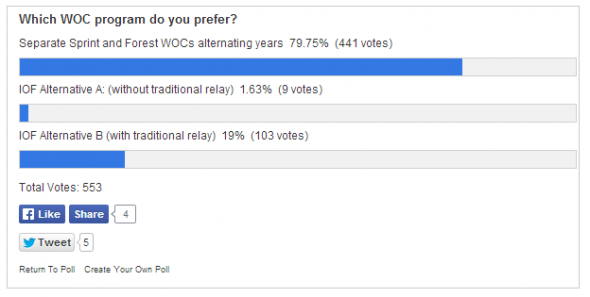
WOC Program from 1966 until today
There have been several changes in the WOC program since the start in 1966. From the start the championships was organized every second year with only long distance (without qualification) and a 4 runner relay, i.e. 2 races. Then the short distance + qualification (later changed to middle distance) was introduced in 1991, increasing to 4 races. The long qualification was added in 1993 (5 races) and the sprint format was added in 2001 (7 races).
In 2003 the biggest change so far occured; WOC went from being organized every second year to every year – at the same time the relay was cut to three runners (still 7 races) . In 2014 another big change occured, after heated discussions the qualifications for long and middle were removed and a (Mixed) Sprint Relay was introduced (6 races).
Disclaimer: The author of this article has been part of the group reviewing the IOF competition program.
 World of O News
World of O News
